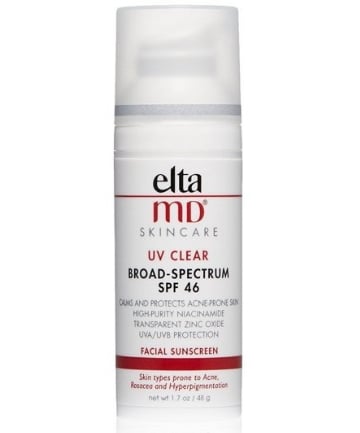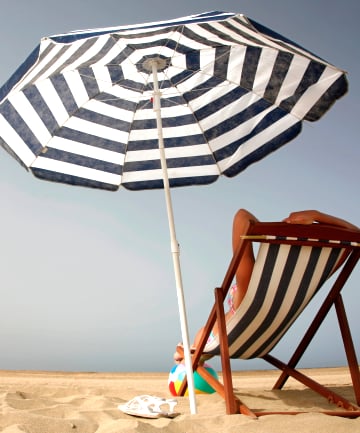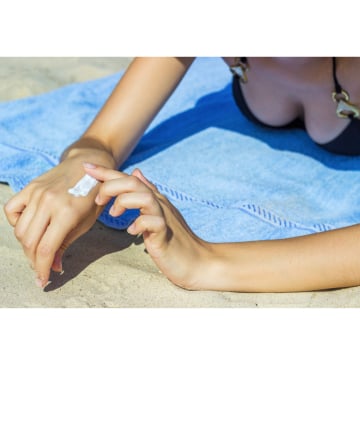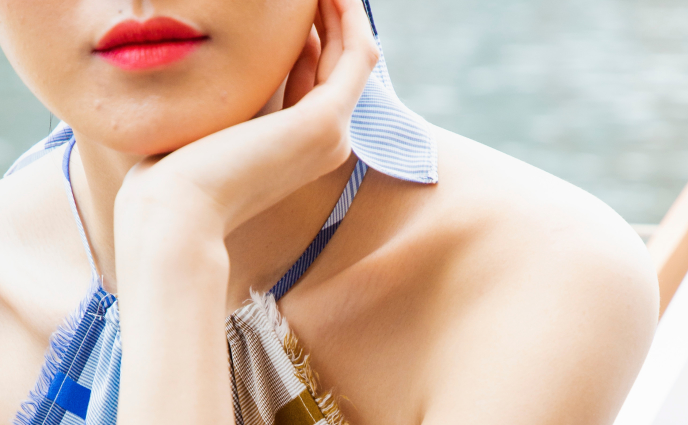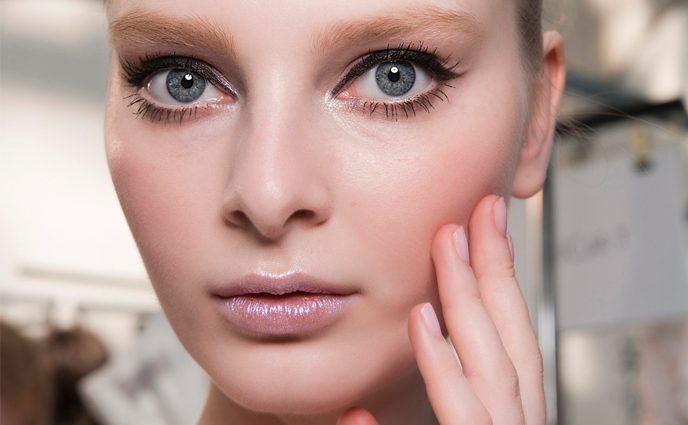The first, and arguably most important step in your beach day beauty routine should be applying sunscreen. Choose a broad-spectrum sunscreen (meaning it protects against UVA and UVB rays) with an SPF of 30 or higher, advises Melanie Palm, MD, dermatologist in San Diego. We like EltaMD UV Clear Broad-Spectrum Sunscreen SPF 46, which shields skin from the sun using transparent zinc oxide and is fragrance-free, oil-free, paraben-free, and non-comedogenic, making it a great option for sensitive and acne-prone skin types.
Just make sure to slather on your sunscreen of choice liberally, 30 minutes before getting to the beach so that the sunscreen has time to get to work. "To ensure that you get the full SPF of a sunscreen, you need to apply one ounce — about a shot glass full," says Gretchen Frieling, MD, dermatopathologist in Boston. "Studies show that most people apply only half to a quarter of that amount, which means the actual SPF they have on their body is lower than advertised."
During a long day at the beach, you should use anywhere from a quarter to a half of an eight-ounce bottle of sunscreen, says Frieling, reapplying every two hours. "Sunscreens should also be reapplied immediately after swimming, toweling off, or sweating a great deal," says Frieling. Palm adds that a mineral powder sunscreen brush is great for reapplication.
Buy now
Just make sure to slather on your sunscreen of choice liberally, 30 minutes before getting to the beach so that the sunscreen has time to get to work. "To ensure that you get the full SPF of a sunscreen, you need to apply one ounce — about a shot glass full," says Gretchen Frieling, MD, dermatopathologist in Boston. "Studies show that most people apply only half to a quarter of that amount, which means the actual SPF they have on their body is lower than advertised."
During a long day at the beach, you should use anywhere from a quarter to a half of an eight-ounce bottle of sunscreen, says Frieling, reapplying every two hours. "Sunscreens should also be reapplied immediately after swimming, toweling off, or sweating a great deal," says Frieling. Palm adds that a mineral powder sunscreen brush is great for reapplication.
Buy now
Beyond sunscreen, UPF (ultra violet protection factor) clothing is another weapon you can add to your arsenal to prevent sunburn at the beach, says Palm. UPF is the rating system used for clothing. It measures a piece of clothing's effectiveness against both UVA and UVB rays. You can find clothing, like rashguards and cover-up dresses, with a UPF rating of 15 all the way to 50+. "UPF clothing has come along way and is more comfortable, functional, and stylish than in years past," says Palm.
Palm also advises making sure your head and the back of your neck are covered. "A neck buff is a great way to keep the latter covered," she explains. Meanwhile, a broad-brimmed hat can protect your head and the back of your neck. It's also easy to find longer-sleeve styles with thumbholes to keep the back of your hands and arms covered, she adds.
Image via Imaxtree
Palm also advises making sure your head and the back of your neck are covered. "A neck buff is a great way to keep the latter covered," she explains. Meanwhile, a broad-brimmed hat can protect your head and the back of your neck. It's also easy to find longer-sleeve styles with thumbholes to keep the back of your hands and arms covered, she adds.
Image via Imaxtree
The sun's rays are at their strongest during the hours of 10 a.m. to 2 p.m., says Palm, so try to plan outdoor activities outside of this window. (As a bonus, you're sure to find a parking spot when you skip out on going to the beach during peak UV hours.) And when you are at the beach, shade is most definitely where it's at: "Seek shade and be aware that even on cloudy days 80 percent of UV rays still penetrate the earth's surface," says Palm. So don't forget to pack the umbrella!
Image via Alex Bramwell/Getty
Image via Alex Bramwell/Getty
Paying attention to your face, arms, and legs is great, but there are some easily overlooked areas that need to be protected at the beach too. "If you do step out, make sure your eyes are covered with sunglasses and lips protected with a balm," says Sheel Desai Solomon, MD, a dermatologist based in Raleigh, North Carolina. "We often forget that the skin around the eyes is very delicate and needs extra attention." Other areas that are easily missed are your scalp, neck, backs of your ears, and tops of your hands and feet, according to the Skin Cancer Foundation.
Image via Mykola Sosiukin/EyeEm/Getty
Image via Mykola Sosiukin/EyeEm/Getty
Sometimes sunburns happen, no matter how well you think you've protected yourself. If you find yourself with a sunburn, Solomon recommends taking frequent, cool baths or showers to relieve the pain. "As soon as you get out of the bathtub or shower, gently pat yourself dry, but leave a little water on your skin," she says. "Then, apply a moisturizer to help trap the water in your skin. This can help ease the dryness." Solomon suggests a moisturizer with aloe vera or soy to help soothe sunburned skin. An OTC hydrocortisone cream may help as well.
Other steps you can take to minimize the discomfort of a sunburn: Pop an aspirin or ibuprofen to help reduce swelling and redness, and drink extra water to prevent dehydration since, as Solomon puts it, "a sunburn draws fluid to the skin's surface and away from the rest of the body."
Head to the doc pronto if you have severe blistering over a large portion of your body, fever and chills, or are woozy and confused, advises Solomon. "Don't scratch or pop blisters, which can lead to infection," she says. "Signs of infection include red streaks or oozing pus."
Image via Rita Saitta/EyeEm/Getty
Other steps you can take to minimize the discomfort of a sunburn: Pop an aspirin or ibuprofen to help reduce swelling and redness, and drink extra water to prevent dehydration since, as Solomon puts it, "a sunburn draws fluid to the skin's surface and away from the rest of the body."
Head to the doc pronto if you have severe blistering over a large portion of your body, fever and chills, or are woozy and confused, advises Solomon. "Don't scratch or pop blisters, which can lead to infection," she says. "Signs of infection include red streaks or oozing pus."
Image via Rita Saitta/EyeEm/Getty



